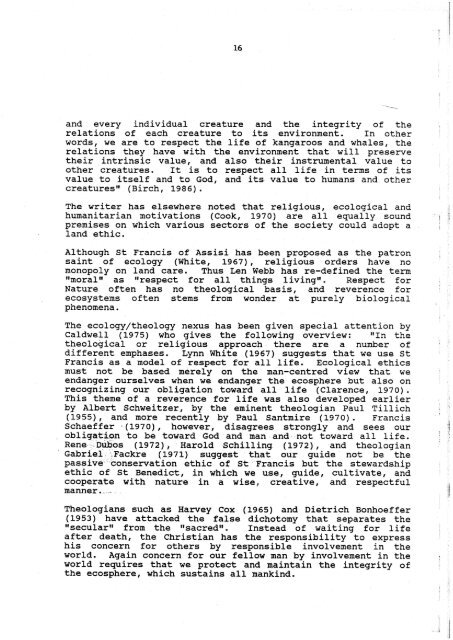soil-conservation-people-religion-and-land.pdf - South West NRM
soil-conservation-people-religion-and-land.pdf - South West NRM
soil-conservation-people-religion-and-land.pdf - South West NRM
You also want an ePaper? Increase the reach of your titles
YUMPU automatically turns print PDFs into web optimized ePapers that Google loves.
<strong>and</strong> every individual creature <strong>and</strong> the integrity of the<br />
relations of each creature to its environment. In other<br />
words, we are to respect the life of kangaroos <strong>and</strong> whales, the<br />
relations they have with the environment that will preserve<br />
their intrinsic value, <strong>and</strong> also their instrumental value to<br />
other creatures. It is to respect all life in terms of its<br />
value to itself <strong>and</strong> to God, <strong>and</strong> its value to humans <strong>and</strong> other<br />
creature^^^ (Birch, 1986) .<br />
The writer has elsewhere<br />
humanitarian motivations<br />
premises on which various<br />
l<strong>and</strong> ethic.<br />
noted that religious, ecological <strong>and</strong><br />
(Cook, 1970) are all equally sound<br />
sectors of the society could adopt a<br />
Although St Francis of Assisi has been proposed as the patron<br />
saint of ecology (White, 1967), religious orders have no<br />
monopoly on l<strong>and</strong> care. Thus Len Webb has re-defined the term<br />
"moralvw as "respect for all things livingmt. Respect for<br />
Nature often has no theological basis, <strong>and</strong> reverence for<br />
ecosystems often stems from wonder at purely biological<br />
phenomena.<br />
The ecology/theology nexus has been given special attention by<br />
Caldwell (1975) who gives the following overview: "In the<br />
theological or religious approach there are a number of<br />
different emphases. Lynn White (1967) suggests that we use St<br />
Francis as a model of respect for all life. Ecological ethics<br />
must not be based merely on the man-centred view that we<br />
endanger ourselves when we endanger the ecosphere but also on<br />
recognizing our obligation toward all life (Clarence, 1970).<br />
This theme of a reverence for life was also developed earlier<br />
by Albert Schweitzer, by the eminent theologian Paul Tillich<br />
(1955), <strong>and</strong> more recently by Paul Santmire (1970). Francis<br />
Schaef fer (1970) , however, disagrees strongly <strong>and</strong> sees our<br />
obligation to be toward God <strong>and</strong> man <strong>and</strong> not toward all life.<br />
Rene Dubos (1972) , Harold Schilling (1972) , <strong>and</strong> theologian<br />
Gabriel. Fackre (1971) suggest that our guide not be the<br />
passive <strong>conservation</strong> ethic of St Francis but the stewardship<br />
ethic of St Benedict, in which we use, guide, cultivate, <strong>and</strong><br />
cooperate with nature in a wise, creative, <strong>and</strong> respectful<br />
manner ., - -<br />
Theologians such as Harvey Cox (1965) <strong>and</strong> Dietrich Bonhoeffer<br />
(1953) have attacked the false dichotomy that separates the<br />
"secular1f from the twsacredw. Instead of waiting for life<br />
after death, the ~hristian has the responsibility to express<br />
his concern for others by responsible involvement in the<br />
world. Again concern for our fellow man by involvement in the<br />
world requires that we protect <strong>and</strong> maintain the integrity of<br />
the ecosphere, which sustains all mankind.
















